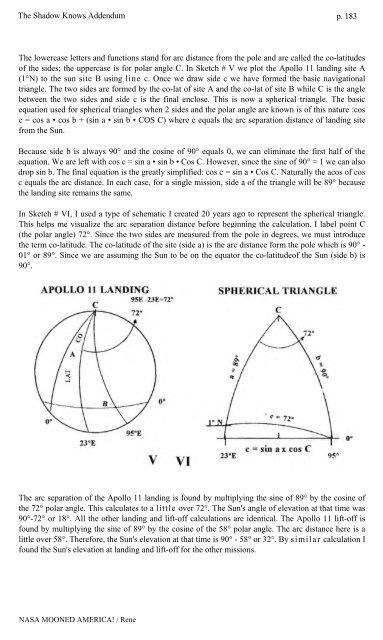Rene-NASA-Mooned-America
Rene-NASA-Mooned-America
Rene-NASA-Mooned-America
You also want an ePaper? Increase the reach of your titles
YUMPU automatically turns print PDFs into web optimized ePapers that Google loves.
The Shadow Knows Addendum p. 183<br />
The lowercase letters and functions stand for arc distance from the pole and are called the co-latitudes<br />
of the sides; the uppercase is for polar angle C. In Sketch # V we plot the Apollo 11 landing site A<br />
(1°N) to the sun site B using line c. Once we draw side c we have formed the basic navigational<br />
triangle. The two sides are formed by the co-lat of site A and the co-lat of site B while C is the angle<br />
between the two sides and side c is the final enclose. This is now a spherical triangle. The basic<br />
equation used for spherical triangles when 2 sides and the polar angle are known is of this nature :cos<br />
c = cos a • cos b + (sin a • sin b • COS C) where c equals the arc separation distance of landing site<br />
from the Sun.<br />
Because side b is always 90° and the cosine of 90° equals 0, we can eliminate the first half of the<br />
equation. We are left with cos c = sin a • sin b • Cos C. However, since the sine of 90° = 1 we can also<br />
drop sin b. The final equation is the greatly simplified: cos c = sin a • Cos C. Naturally the acos of cos<br />
c equals the arc distance. In each case, for a single mission, side a of the triangle will be 89° because<br />
the landing site remains the same.<br />
In Sketch # VI, I used a type of schematic I created 20 years ago to represent the spherical triangle.<br />
This helps me visualize the arc separation distance before beginning the calculation. I label point C<br />
(the polar angle) 72°. Since the two sides are measured from the pole in degrees, we must introduce<br />
the term co-latitude. The co-latitude of the site (side a) is the arc distance form the pole which is 90° -<br />
01° or 89°. Since we are assuming the Sun to be on the equator the co-latitudeof the Sun (side b) is<br />
90°.<br />
The arc separation of the Apollo 11 landing is found by multiplying the sine of 89° by the cosine of<br />
the 72° polar angle. This calculates to a little over 72°. The Sun's angle of elevation at that time was<br />
90°-72° or 18°. All the other landing and lift-off calculations are identical. The Apollo 11 lift-off is<br />
found by multiplying the sine of 89° by the cosine of the 58° polar angle. The arc distance here is a<br />
little over 58°. Therefore, the Sun's elevation at that time is 90° - 58° or 32°. By similar calculation I<br />
found the Sun's elevation at landing and lift-off for the other missions.<br />
<strong>NASA</strong> MOONED AMERICA! / <strong>Rene</strong>


